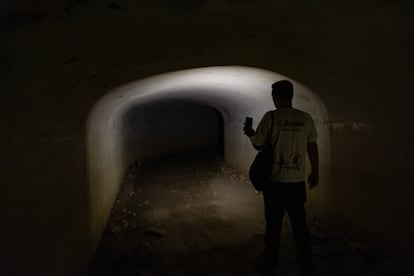The Strait of Gibraltar bunkers that Franco never used
Around 30,000 prisoners toiled in abject conditions to build 640 military stuctures from which the Nazis planned to attack the Rock, but which were ultimately abandoned


Larissa Swirski and Gabriel Riera probably never met, although both survived that dangerous and intriguing scenario that was the Strait of Gibraltar during World War II; she, as the Queen of Hearts, a double agent for the Nazis and the Allies in Gibraltar’s espionage network, which the British christened Spy Row; he, as a prisoner forced to eat crushed snails to avoid starvation while digging a huge tunnel under the Carbonera mountain range to be used in a German offensive against the Rock that never transpired. Although the history books dwell on other exploits, a tense and discreet battle was fought in Cádiz in the early 1940s; one of frustrated military operations, spies and battalions of prisoners who built more than 640 bunkers and various military infrastructures that were soon to be abandoned to their fate along the coast of Cádiz.
Bunkers, anti-aircraft guns, command posts, tunnels and even a hidden road to Algeciras are living witnesses to a war fought in one of the essential geostrategic corners of the world in which no shots were fired. The infrastructure that extends along the coastline of Cádiz, from Huelva to Málaga, was part of the so-called Plan of Fortifications of the Southern Border, devised by the artillery brigadier general Pedro Jevenois Labernade in May 1939. Just before World War II, Franco’s military studied a fortification and artillery plan that would officially serve to defend the country against possible incursions from the Allied forces. “We are talking about a very serious project,” says Alfonso Escuadra, an expert on the military legacy in Cádiz and its historical context. “Together with the system of fortifications on the Pyrenees line [the so-called P Line, which consisted of 6,000 bunkers built between 1944 and 1948] they are the great defense constructions of the era.”
But no matter how much the Franco regime insisted the fortifications of the Strait of Gibraltar were only for defense purposes, no one would deny that whoever controlled the Strait and the Suez Canal would have the keys to the Mediterranean. In 1940, the regime erected a fortified line, especially dense around Gibraltar. “All the elements of the artillery system and observatories have an offensive nuance,” says Escuadra. On account of this, Nazi Germany included the bunkers that same year as key aspects of Operation Felix – Hitler’s plan to invade Gibraltar in January 1941.

“Some people still think that in the Hendaye interview [held between Franco and Hitler in October 1940 to discuss Spain’s entry into the war], no agreement was reached, but that is not so,” says Escuadra. “The fortifications were used as a key element in the negotiations.” In fact, secret documents surfaced in the German Bundesarchiv in which the Nazi general Hubert Lanz declares that the Spanish state had “given him several bunkers located in La Línea.” Escuadra believes it is clear that the plan to invade Gibraltar involved a far greater degree of participation from the Franco regime than has been historically assumed. But the preparations for the seizure of the Rock ended up going awry, as they overlapped with the operation for the German occupation of the USSR, and the subsequent shift of advantage to the Allies.
A discreet war
Meanwhile, on the ground in the Campo de Gibraltar, there was plenty of espionage and even double agents, like Swirski, whose fascinating life has been documented by the journalist Wayne Jamison.
And if it was possible for Franco’s dictatorship to erect more than 640 defensive constructions in just a few months, it was because the state used private contractors, the military and, above all, thousands of prisoners forced to work in extreme conditions. The historian José Manuel Algarbani has calculated the existence of as many as 43 disciplinary units from May 1939 to 1944. “There is the well-known case of the Valley of the Fallen, where there were up to 20,000 prisoners who worked on its construction, but here were 30,000 here, something that few people are aware of,” he says.
According to the journalist and researcher Juan José Téllez, “we have lived under the illusion that Spain did not participate in World War II. But tell that to the residents of La Línea de la Concepción, who were at the receiving end of an Italian bombing of Gibraltar by mistake [on July 11, 1941, with five fatalities].”
When the humid easterly wind from the Strait of Gibraltar mixes with fog, the Rock disappears behind clouds. Looking out from a bunker in the Sierra Carbonera, the apparent absence makes the existence of the bunkers seem even more futile as well as the suffering their construction entailed. “This is only a part of it; in San Roque we have a bunker for every square kilometer,” says Carlos Jordán, who works in the city’s department for tourism and is responsible for cultural routes through these dilapidated structures. “There are more than 180 in the municipality alone.”

Gabriel Riera, a native of the island of Mallorca, was one of the prisoners who worked on this infrastructure and he documented his experience in Chronicle of a Mallorcan Prisoner in the Concentration Camps (1936-1942): “One day, an inspection team showed up with a colonel of health,” he wrote. “The remaining members of the company were made to line up; there were no longer many of us, and, as we crossed the wire netting, he said: ‘This is a graveyard of living men!’” The lack of food, the diseases, accidents plus work shifts of more than 10 hours a day caused the death of at least 500 prisoners, according to Algarbani. They were useless fatalities, the price of building a fortified line that was never used and which fell into disuse as soon as Franco saw that it was not going to serve either to attack or to defend against the Allies.
Today, the bunkers barely survive as megaliths along a coast that has remained, to a large extent, natural and wild due to the military needs in the area. Mired in a tangle of administrative and property ownership issues, there is no consensus as to how many there are. In 2001, Escuadra and Ángel Sáez made a catalog for the regional Ministry of Culture in which they documented some 500 structures, but Escuadra believes there may be more. Jordán, meanwhile, estimates more than 640, for which he calls for protection as assets of cultural interest (BIC), something promised by the regional government in September 2019. Consulted by EL PAÍS, the Andalusian department of culture has not specified whether it will declare them assets of cultural interest but says that “as part of defensive architecture, the bunkers already have the consideration of BIC in application of the 1985 Heritage Act.”
Algarbani and Escuadra have both been working for decades to rescue the buildings from oblivion, as they are located in areas with undoubted tourist appeal. Eager that the role of the bunkers as places of historical memory should be recognized, Alharbani says, “We have to explain how they were built and why, in order to make them places of memory, and not to destroy them.”
Escuadra goes further. “In two decades, they will be 100 years old and they speak to us about our history,” he says. “Plus this is not a local issue; it places the area in the context of European and world history.”
English version by Heather Galloway.
Tu suscripción se está usando en otro dispositivo
¿Quieres añadir otro usuario a tu suscripción?
Si continúas leyendo en este dispositivo, no se podrá leer en el otro.
FlechaTu suscripción se está usando en otro dispositivo y solo puedes acceder a EL PAÍS desde un dispositivo a la vez.
Si quieres compartir tu cuenta, cambia tu suscripción a la modalidad Premium, así podrás añadir otro usuario. Cada uno accederá con su propia cuenta de email, lo que os permitirá personalizar vuestra experiencia en EL PAÍS.
¿Tienes una suscripción de empresa? Accede aquí para contratar más cuentas.
En el caso de no saber quién está usando tu cuenta, te recomendamos cambiar tu contraseña aquí.
Si decides continuar compartiendo tu cuenta, este mensaje se mostrará en tu dispositivo y en el de la otra persona que está usando tu cuenta de forma indefinida, afectando a tu experiencia de lectura. Puedes consultar aquí los términos y condiciones de la suscripción digital.
More information
Últimas noticias
There is as much life left to discover on planet Earth as that which is already known
Dozens presumed dead, around 100 injured in fire at Swiss Alps bar during New Year’s celebration
Is porn for women different from conventional porn? We spoke to those who make it
Cartagena de Indias is sinking: What can the city do to mitigate it?
Most viewed
- Reinhard Genzel, Nobel laureate in physics: ‘One-minute videos will never give you the truth’
- David King, chemist: ‘There are scientists studying how to cool the planet; nobody should stop these experiments from happening’
- Sinaloa Cartel war is taking its toll on Los Chapitos
- Oona Chaplin: ‘I told James Cameron that I was living in a treehouse and starting a permaculture project with a friend’
- The Interoceanic Train, the Mexican alternative to the Panama Canal










































